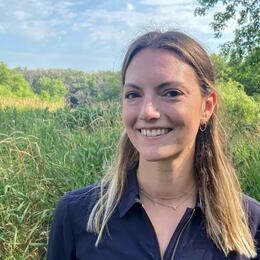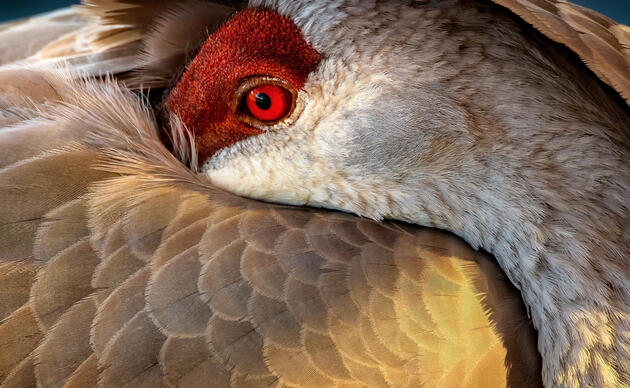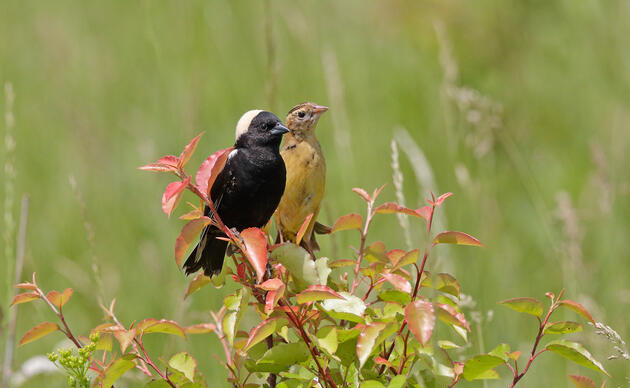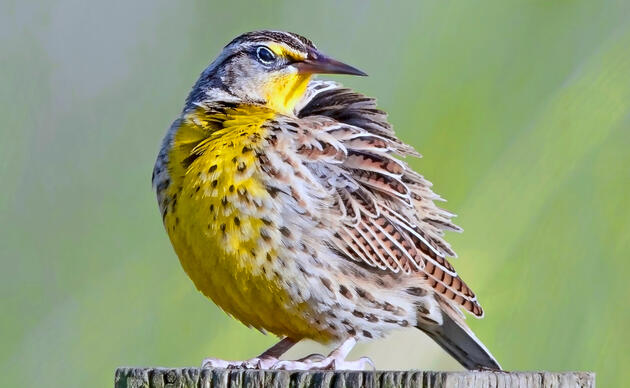This March, I loaded up my outfitted 2004 Chevy Astro Van, lovingly named the AstroLoon, and made the journey from my home in Fargo, North Dakota, 516 miles to Audubon’s Rowe Sanctuary in Buffalo County, Nebraska. I was able to park my van close enough to the river that my mornings and evenings were filled with the sounds of cranes during my time in Nebraska. As one of 19 Audubon employees participating in a staff exchange at Rowe Sanctuary, I experienced crane season as both a first-time visitor and volunteer.
My first real experience seeing the cranes was a frigid morning guided tour to the East Blind. As our guide told us we were about to witness one of the last great migrations left in North America, I could sense the anticipation around me. Wintery weather had settled in the previous day, but was no match for the bundled thrill-seekers piling into the blind with our red flashlights pointing towards our feet, binoculars at the ready for the sun to show us the hundreds of Cranes roosting on the Platte River. We could hear the Cranes before we could see them. The variety of calls and trumpets, whistles from the juveniles and flaps of wings, made for a cacophony of noise that pulled your attention to the river.
As the sun began to rise, silhouettes of black stood stark against the indigo sky. More light revealed a swath of cranes moving, swishing through the water, occasionally dancing, and always chattering to each other.
The frigid air only made the sounds feel closer, like we were all a part of these birds’ conversations about where they had been, wintering in places like New Mexico and parts of Texas, and where they were headed to next, northern Canada and Siberia.
All at once, an east flank of birds rose into the air, swirling around and seemingly calling out in one voice. Like cheers from a thousand-fold crowd, the sound rose and fell as a crowd of cranes flew towards the fields to find forage for the day, and others whirled back to the river, floating ever so gracefully like a parachutist finding the perfect landing among the sandbars.
After seeing it for the first time, I couldn’t get enough. Every tour, whether I was assisting with the guiding or not, was so unique; it is so special to see these beautiful birds chattering, swirling in the skies, or touching down to the sandbars in their nighttime routine.
Volunteering at Rowe involved taking tours out to one of four viewing blinds along the Platte River with a co-guide in the mornings and evenings. My fellow guides and I would talk through viewing blind etiquette to ensure the safety of the birds and a good experience for our guests, explaining some crane facts and what to watch for on the river, and answering any questions that the guests had about the cranes, their habitat along the Platte River, and Rowe Sanctuary. I also worked with guests from the four overnight photo blinds that were booked by enthusiastic birders looking to have a more up-close and personal experience with the birds on the river.
We welcomed folks from behind the information table in the large white tent that had become the command center for this year’s crane season while Rowe’s permanent Center building is under construction. A larger and more accommodating building for all of Rowe’s activities will be completed this fall. Even with the temporary changes that occurred this Rowe’s crane season due to the construction, the visitors and volunteers were ready to enjoy and experience everything that came their way.
It seemed I was always in the right place at the wrong time so see Whooping Cranes, but they did make an appearance several times around the area while I was in Nebraska. However, as rare as it is to find a flock of kettling Whooping Cranes, it’s rarer still to find a group of people so dedicated to a single mission that they travel hundreds of miles to volunteer for days on end, year after year just to share their experience with people who love the Sandhill Cranes and their habitat.
After speaking to several volunteers, I found that not only had they been coming back to Rowe annually, but a few volunteers also coordinated together so that their schedules would align for the same week so they could work with the same group of friends. The ownership, care, and passion of the volunteers at Rowe is invaluable to the experiences that I and the other guests have had here. My time guiding tours, visiting with volunteers and the full-time staff at Rowe Sanctuary, has been highlight of my year.






